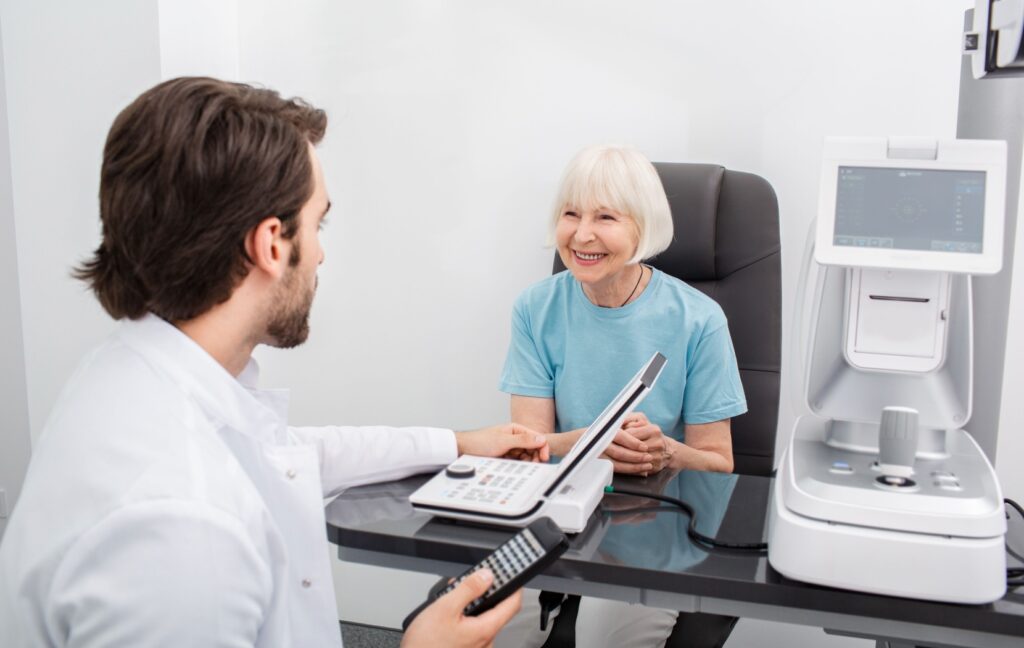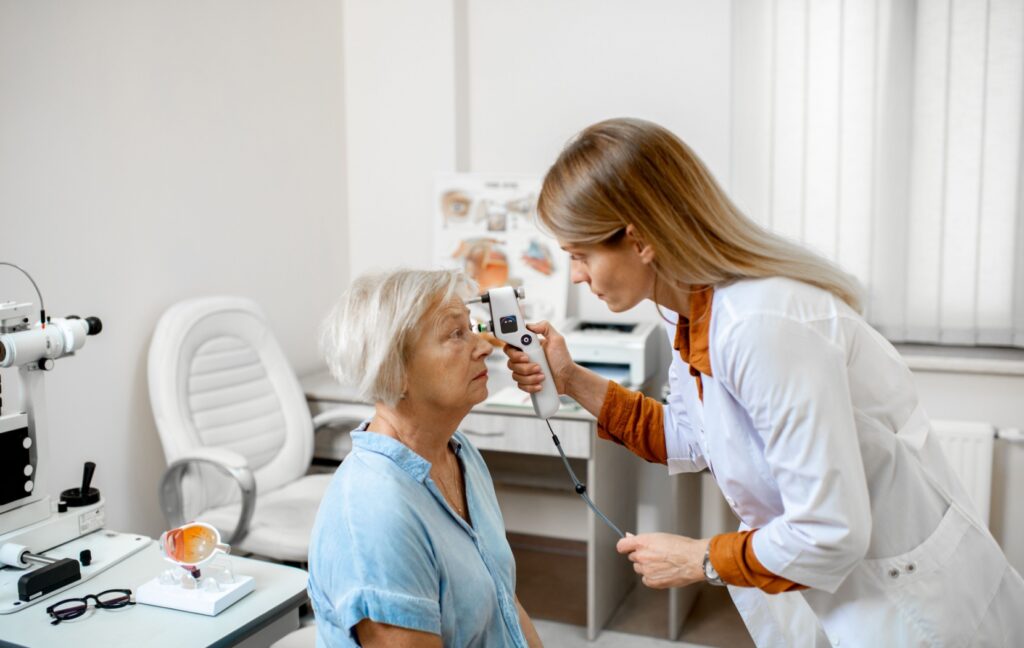As we age, regular eye exams become essential for maintaining our overall health. For seniors, understanding and monitoring eye pressure is crucial, as it plays a significant role in preventing and managing conditions like glaucoma.
But what exactly is normal eye pressure? Normal eye pressure ranges from 10-21 mmHg, but it varies from person to person and is influenced by a variety of factors, including age. These variations make regular eye exams crucial for seniors.
What Is Eye Pressure?
Eye pressure, or intraocular pressure (IOP), refers to the fluid pressure inside the eye. This pressure is regulated by a delicate balance between the production and drainage of a fluid called aqueous humor, which nourishes the eye and maintains its shape.
Healthy eye pressure ensures optimal visual function, while a disturbance in this balance can lead to vision problems or damage.
The Link Between Eye Pressure & Glaucoma
Glaucoma, often called the “silent thief of sight,” is a group of eye conditions that damage the optic nerve, which is essential for clear vision. Elevated eye pressure is one of the primary risk factors for glaucoma, although the condition can also occur with normal eye pressure. If left untreated, glaucoma can lead to irreversible vision loss.
Why Eye Pressure Matters
High intraocular pressure places increased strain on the optic nerve, potentially causing permanent damage. However, low eye pressure can also signal issues like eye inflammation or the aftermath of an injury. Striking the right balance is key to maintaining eye health.
What Is Normal Eye Pressure?
Normal eye pressure typically ranges between 10 and 21 millimeters of mercury (mmHg). However, “normal” can vary from person to person based on factors like age, medical history, and overall health. For seniors, this range is often affected by age-related changes in the eyes and the presence of other medical conditions.
It’s vital to note that having a normal eye pressure reading doesn’t guarantee that there’s no risk of glaucoma or other conditions. Regular eye exams are indispensable for identifying and managing potential issues early.
Factors Affecting Eye Pressure in Seniors
Seniors may experience fluctuations in eye pressure due to various factors, including:
- Age: Aging naturally changes the structure and function of the eye, which can influence fluid circulation and pressure levels.
- Family history: A family history of glaucoma or other eye conditions increases the likelihood of pressure-related issues.
- Medical conditions: Conditions such as diabetes, high blood pressure, and cardiovascular issues can impact eye pressure.
- Medications: Certain medications, including corticosteroids, can elevate eye pressure.
- Lifestyle Choices: Factors like smoking, lack of exercise, or prolonged screen time may also contribute to pressure changes.
Symptoms of Abnormal Eye Pressure
Detecting abnormal eye pressure on your own is difficult because it often doesn’t cause noticeable symptoms until the pressure becomes extremely high or optic nerve damage has already occurred. However, some warning signs might include:
- Blurred or foggy vision
- Severe eye pain
- Halos around lights
- Headaches
- Sudden vision loss (in advanced cases)
Experiencing any of these symptoms warrants an immediate visit to an eye care professional.

How Seniors Can Monitor Eye Pressure and Protect Vision
Regular eye health monitoring can go a long way in preventing complications. Here’s a step-by-step guide for seniors:
1. Schedule Regular Eye Exams
The American Optometric Association recommends that people over 60 have a comprehensive eye exam at least once a year to check for glaucoma and other age-related conditions.
2. Know Your Baseline
Ask your eye doctor to establish your baseline eye pressure measurement. This information can help track any fluctuations or changes over time.
3. Adopt a Healthy Lifestyle
- Exercise regularly: Activities like walking, swimming, and yoga can improve overall health and potentially lower eye pressure.
- Eat a balanced diet: Foods rich in antioxidants (like leafy greens, carrots, and fish rich in omega-3 fatty acids) promote eye health.
- Stay hydrated: Proper hydration helps maintain optimal fluid balance in the eyes and the body overall.
4. Manage Chronic Conditions
Keep conditions like diabetes and high blood pressure under control to protect eye health.
5. Follow Doctor’s Recommendations
If you’ve been diagnosed with abnormal eye pressure or glaucoma, follow prescribed treatments, which may include medications like eye drops or surgical interventions.
Advanced Options for Managing Eye Pressure
For seniors managing high eye pressure or glaucoma, specialized treatments are often necessary. These include:
- Medicated eye drops: Designed to reduce eye pressure by either decreasing fluid production or improving drainage in the eye.
- Laser surgery: Procedures such as Selective Laser Trabeculoplasty (SLT) can improve fluid outflow and lower eye pressure.
- Minimally invasive glaucoma surgery (MIGS): Recent advancements in eye care allow for safer, less invasive procedures to regulate eye pressure effectively.
Consult with a certified eye care specialist to determine the best course of action based on your individual needs.
Protect Your Vision, Protect Your Independence
Maintaining healthy eye pressure is a critical aspect of overall wellness for seniors. Staying informed, adopting a healthy lifestyle, and scheduling regular eye exams are vital steps in safeguarding your vision. Remember, eye health is about more than just seeing clearly; it’s also about preserving your independence and quality of life.
At Old Town Optix Optometry, we’re committed to helping seniors maintain optimal eye health. Our team of experienced professionals offers comprehensive eye exams and personalized care to address your unique needs. Take the first step towards healthy vision today. Book your appointment with us and protect your sight for years to come.



